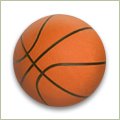 www.LSUsports.net
www.LSUsports.netHere's a real case of Basketball Medicine!
I just read a release from the LSU Women's Basketball program that Katy Antony has passed up her senior season so that she can focus on being accepted into medical school. Kudos to Ms. Antony for making this hard decision, and kudos to her coach, Hall-of-Famer Van Chancellor, who supported her decision to leave the team.
Playing college basketball and pre-medical studies usually don't mix well. The time commitments of these two pursuits almost always force a student-athlete to leave one behind. While there are a few special people and special circumstances where Division 1 college basketball players make it into medical school, you can't fault this smart (National Honor Society President and High School Valedictorian) and talented (a former 2003 Louisiana Miss Basketball and Gatorade Louisiana Player of the Year) young lady for her decision to concentrate on her pre-medical studies.
I hope that her basketball experience and lessons learned on the court will help her in medical school and residency programs.
And hey, if she decides to enroll at UNC's School of Medicine, I call first dibs on her for our intramural team!!












